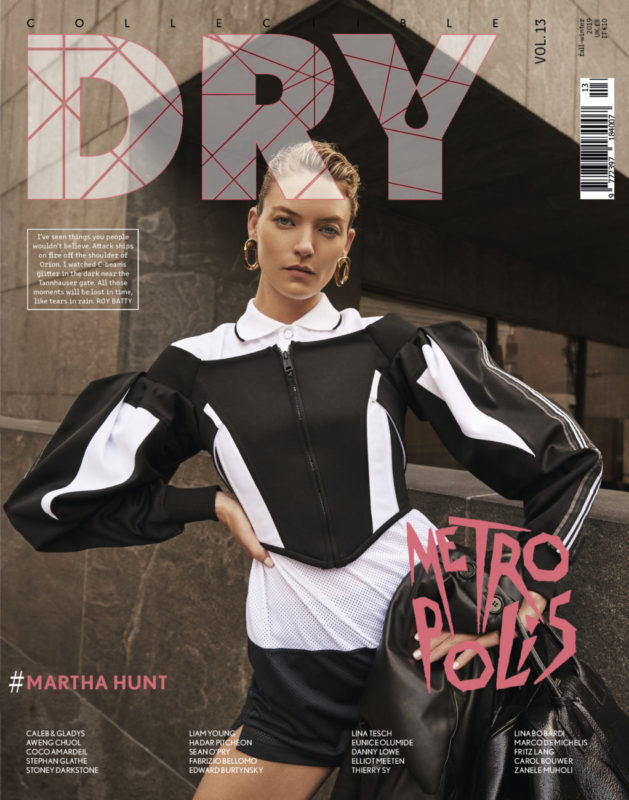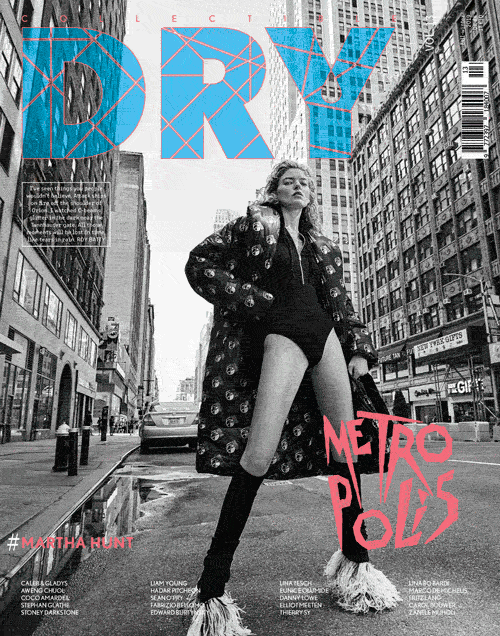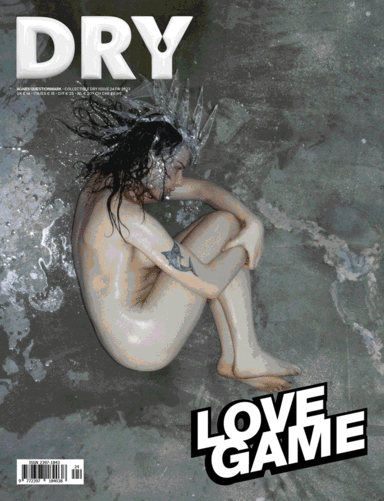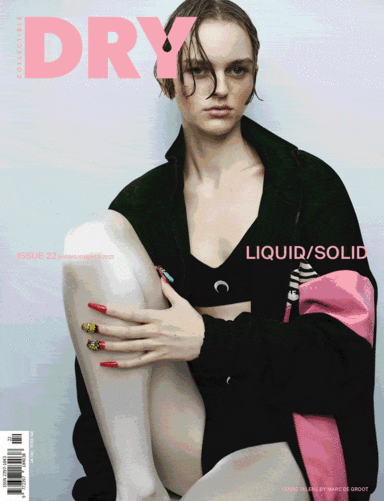metropolis
IN THIS ISSUE:
Sean O’Pry
MARTHA
HUNT
Lina
Bo Bardi
FRITZ LANG
CALEB & GLADYS
ELLIOT
MEETEN
Edward
Burtynynsky
COCO ARMARDEIL
Marco De
Michelis
HADAR
PITCHON
Eunice
Olumide
Aweng Choul
Liam
Yang
Editorial:
the METROPOLIS
the CAPITAL
the SOUL
The metropolis, the traditional “big scene of progress” is actually the most backward and confused domain of the capital’s practices. To the point that you might ask yourself whether the modern city is less an unresolved problem than an objectively obsolete phenomenon. By demistifying the complex ideology that has accompanied this debate, influencing the shape it takes, the metropolis ceases to be a “place” in order to become a “condition”; and it is precisely this condition that is made to circulate uniformly through the social phenomenon by means of consumption.
The future dimension of the metropolis coincides with that of the market… in fact, it doesn’t exist anymore a reality outside the system itself. The city no longer “represents” the system but “becomes” the system itself. Through consumption this system is radically conditioning life on our planet with the devastating effects that we are all familiar with but unable to remedy. In this issue, evocative fashion and art images describe the soul and contradictions of an imagined distopian pastpresent- future that is now prophesied. Martha Hunt and Sean O’Pry, along with other iconic faces, star in stories that unfold like the chapters of a book, suggestions from films or novels. With artists like multifaceted philospherphotographer Fabrizio Bellomo, sci-fi architect Liam Young, the city portraitist Vincenzo Castella, Mario Schifano and his amazing unreleased images from a trip in America, Zanele Muhole in Capetown described through the words of art patron Carole Bouwer. And then the extraordinary interview with Professor Marco de Michelis and the feminist statement of Eunice Olumide, transformed in a body-manipulated sculpture. But back in 1903, well over a century ago, Georg Simmel, the great German sociologist, wrote an essay analysing the impact of the metropolis upon humans that has lost none of its relevance today.
#DON’T REPEAT YOURSELF
“The deepest problems of modern life flow from the attempt of the individual to maintain the independence and individuality of his existence against the sovereign powers of society, against the weight of the historical heritage and the external culture and technique of life. This antagonism represents the most modern form of the conflict which primitive man must carry on with nature for his own bodily existence.
The eighteenth century may have called for liberation from all the ties which grew up historically in politics, in religion, in morality and in economics in order to permit the original natural virtue of man, which is equal in everyone, to develop without inhibition; the nineteenth century may have sought to promote, in addition to man’s freedom, his individuality (which is connected with the division of labour) and his achievements which make him unique and indispensable but which at the same time make him so much the more dependent on the complementary activity of others; Nietzsche may have seen the relentless struggle of the individual as the prerequisite for his full development, while socialism found the same thing in the suppression of all competition – but in each of these the same fundamental motive was at work, namely the resistance of the individual to being levelled, swallowed up in the social-technological mechanism.
To the extent that the metropolis creates these psycho-logical conditions – with every crossing of the street, with the tempo and multiplicity of economic, occupational and social life – it creates in the sensory foundations of mental life, and in the degree of awareness necessitated by our organization as creatures dependent on differences, a deep contrast with the slower, more habitual, more smoothly flowing rhythm of the sensorymental phase of small town and rural existence.
That we follow the laws of our inner nature – and this is what freedom is – becomes perceptible and convincing to us and to others only when the expressions of this nature distinguish themselves from others; it is our irreplaceability by others which shows that our mode of existence is not imposed upon us from the outside.
First of all there is the difficulty of giving one’s own personality a certain status within the framework of metropolitan life. Where quantitative increase of value and energy has reached its limits, one seizes on qualitative distinctions, so that, through taking advantage of the existing sensitivity to differences, the attention of the social world can, in some way, be won for oneself. This leads ultimately to the strangest eccentricities, to specifically metropolitan extravagances of self-distantiation, of caprice, of fastidiousness, the meaning of which is no longer to be found in the content of such activity itself but rather in its being a form of “being different” – of making oneself noticeable. For many types of persons these are still the only means of saving for oneself, through the attention gained from others, some sort of self-esteem and the sense of filling a position.
The development of modern culture is characterized by the predominance of what one can call the objective spirit over the subjective. If we survey, for instance, the vast culture which during the last century has been embodied in things and in knowledge, in institutions and in comforts, and if we compare them with the cultural progress of the individual during the same period – at least in the upper classes – we would see a frightful difference in rate of growth between the two which represents, in many points, rather a regression of the culture of the individual with reference to spirituality, delicacy and idealism.
It need only be pointed out that the metropolis is the proper arena for this type of culture which has outgrown every personal element.
From one angle, life is made infinitely more easy in the sense that stimulations, interests, and the taking up of time and attention, present themselves from all sides and carry it in a stream which scarcely requires any individual efforts for its ongoing. But from another angle, life is composed more and more of these impersonal cultural elements and existing goods and values which seek to suppress peculiar personal interests and incomparabilities. No longer was it the “general human quality” in every individual but rather his qualitative uniqueness and irreplaceability that now became the criteria of his value. In the conflict and shifting interpretations of these two ways of defining the position of the individual within the totality is to be found the external as well as the internal history of our time. It is the function of the metropolis to make a place for the conflict and for the attempts at unification of both of these in the sense that its own peculiar conditions have been revealed to us as the occasion and the stimulus for the development of both.”
The Metropolis and Mental Life is a 1903 book by the German sociologist, Georg Simmel.

ON COVER METROPOLIS
Martha Hunt wears a lambskin down-filled oversized trench coat, logo graphic striped mesh polo shirt dress, medium lambskin cube bag and large gold-plated chain link earrings by Burberry
How to wear a Burberry garment, outfit or trench coat, respecting tradition? Let’s complete with a Burberry perfume. From the collection inspired by English gardens, the most intense fragrance is My Burberry Black which recalls the floral scents enhanced by the sun after a downpour. In the bouquet, notes of jasmine, candied rose and peach nectar on a patchouli background. As in the other series’ perfumes, My Burberry Blush, My Burberry Edp and Edt, the bottle evokes the iconic details of the Maison: the gabardine ribbon and cap allude to the trench coat’s buttons.
Photography Caleb & Gladys. Fashion Sayuri Bloom. Make Up Joseph Carillo @Atelier Management using Guerlain. Hair Felix Fischer @Factory Downtown. Manicurist Kana Kishita. Production Staci Grabina & Ilaria Niccolini @FTL Moda. Model Martha Hunt @IMG. Digital Operator Chris Vongsawat. Photo Assistant Sergio Avellaneda. Beauty Editor Sandra Bardin. Graphic Design Amy Nicoll.

ON COVER METROPOLIS
Sean O’Pry wears a white cotton T-shirt by Celine and latex gloves by Tableaux Vivants
An intriguing masculine look appears in the video of Illusione, a pair of Bottega Veneta perfumes for him and for her, where we don’t know if the brief but enlightening affair between the protagonist and the brunette beauty by the pool is dreamlike or real. In any case, the human couple in the scenario of an Italian villa effectively represents the olfactory message common to the two fragrances: relaxed elegance, freshness, glamor, sex appeal and why not a bit of mystery. With the olfactory differences of gender: Illusion for Him is a vibrant woody-citrus fragrance of vetiver, Illusion for Her is a woody-floral bouquet among taste of fruits and transparent notes.
Photography Hadar Pitchon. Fashion Marc Anthony George. Make Up & Hair Akihisa Yamaguchi, using Living Proof Hair Care. Model Sean O’Pry @VNY Models. Production Andrea Colace. Beauty Editor Sandra Bardin. Graphic Design Amy Nicoll.

ON COVER METROPOLIS
Martha Hunt wears an all over printed puffer coat, cashmere body with zipper and cashmere stockings by Michael Kors Feather heels by Giambattista Valli
She is a bold girl. She loves experiencing, surprising, traveling. To such a vibrant feminine personality, Michael Kors dedicates the mirroring fragrance Wonderlust Sublime Eau de Parfum, a new version of the Wonderlust bestseller that translates a magical vacation in the Southern Seas into paradisiacal sensations. In the revisited bottle in flamboyant gold, the fresh- s picy bouquet of orange flowers, throbbing with Tahitian Tiaré and carnations on an oriental-amber background unfolds the sensual intensity promised by the title.
Photography Caleb & Gladys. Fashion Sayuri Bloom. Make Up Joseph Carillo @Atelier Management using Guerlain. Hair Felix Fischer @Factory Downtown. Manicurist Kana Kishita. Production Staci Grabina & Ilaria Niccolini @FTL Moda. Model Martha Hunt @IMG. Digital Operator Chris Vongsawat. Photo Assistant Sergio Avellaneda. Beauty Editor Sandra Bardin. Graphic Design Amy Nicoll.
Don’t Repeat Yourself
-In USA/WORLDWIDE it will be out late NOVEMBER-



